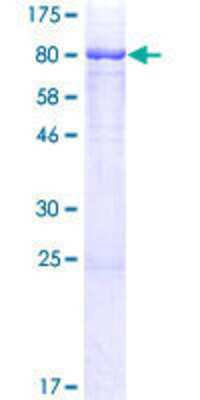CLCC1 Products
Chloride channels (CLCs) regulate cellular traffic of chloride ions, a critical component of all living cells. CLCs are involved in membrane potential stabilization, signal transduction, cell volume regulation and organic solute transport. CLCC1 (Chloride channel CLIC-like protein 1), also known as MCLC (Mid-1-related chloride channel) or KIAA0761, is a 551 amino acid multi-pass membrane protein that belongs to the chloride channel MCLC family. CLCC1 is related to the Saccharomyces cerevisiaeprotein Mid-1 and is believed to function as an intracellular chloride channel that is expressed in lung, brain, muscle, liver and testis. Localizing to intracellular compartments such as the Golgi apparatus, the endoplasmic reticulum (ER) and the nuclear envelope, CLCC1 is expressed as four isoforms due to alternative splicing events, namely hMCLC-1, hMCLC-2, hMCLC-3 and hMCLC-4.
Show More
6 results for "CLCC1" in Products
6 results for "CLCC1" in Products
CLCC1 Products
Chloride channels (CLCs) regulate cellular traffic of chloride ions, a critical component of all living cells. CLCs are involved in membrane potential stabilization, signal transduction, cell volume regulation and organic solute transport. CLCC1 (Chloride channel CLIC-like protein 1), also known as MCLC (Mid-1-related chloride channel) or KIAA0761, is a 551 amino acid multi-pass membrane protein that belongs to the chloride channel MCLC family. CLCC1 is related to the Saccharomyces cerevisiaeprotein Mid-1 and is believed to function as an intracellular chloride channel that is expressed in lung, brain, muscle, liver and testis. Localizing to intracellular compartments such as the Golgi apparatus, the endoplasmic reticulum (ER) and the nuclear envelope, CLCC1 is expressed as four isoforms due to alternative splicing events, namely hMCLC-1, hMCLC-2, hMCLC-3 and hMCLC-4.
Show More
Applications: IHC, ICC/IF, KD
Reactivity:
Human
| Reactivity: | Human |
| Details: | Rabbit IgG Polyclonal |
| Applications: | IHC, ICC/IF, KD |
| Reactivity: | Human |
| Details: | Rabbit IgG Polyclonal |
| Applications: | IHC, ICC/IF |
| Reactivity: | Human |
| Details: | Rabbit IgG Polyclonal |
| Applications: | IHC, WB |
| Applications: | WB, ELISA, MA, AP |
| Applications: | AC |
| Applications: | AC |

![Immunohistochemistry-Paraffin: CLCC1 Antibody [NBP1-82793] Immunohistochemistry-Paraffin: CLCC1 Antibody [NBP1-82793]](https://resources.bio-techne.com/images/products/CLCC1-Antibody-Immunohistochemistry-Paraffin-NBP1-82793-img0017.jpg)
![Immunohistochemistry-Paraffin: CLCC1 Antibody [NBP1-82792] Immunohistochemistry-Paraffin: CLCC1 Antibody [NBP1-82792]](https://resources.bio-techne.com/images/products/CLCC1-Antibody-Immunohistochemistry-Paraffin-NBP1-82792-img0015.jpg)
![Western Blot: CLCC1 Antibody [NBP1-59834] Western Blot: CLCC1 Antibody [NBP1-59834]](https://resources.bio-techne.com/images/products/CLCC1-Antibody-Western-Blot-NBP1-59834-img0001.jpg)
